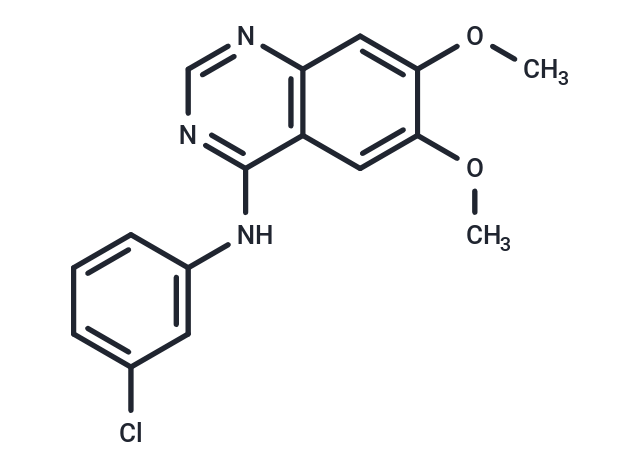Shopping Cart
Remove All Your shopping cart is currently empty
Your shopping cart is currently empty
AG-1478 (NSC-693255) (Tyrphostin AG-1478) is a selective EGFR inhibitor.

| Pack Size | Price | USA Warehouse | Global Warehouse | Quantity |
|---|---|---|---|---|
| 5 mg | $45 | In Stock | In Stock | |
| 10 mg | $61 | In Stock | In Stock | |
| 25 mg | $114 | In Stock | In Stock | |
| 50 mg | $207 | In Stock | In Stock | |
| 100 mg | $288 | In Stock | In Stock | |
| 200 mg | $374 | - | In Stock | |
| 1 mL x 10 mM (in DMSO) | $50 | In Stock | In Stock |
| Description | AG-1478 (NSC-693255) (Tyrphostin AG-1478) is a selective EGFR inhibitor. |
| Targets&IC50 | EGFR:3 nM |
| In vitro | Co-administration of 0.4 mg AG-1478 with a single dose of 25 μCi 90Y-CHX-A''-DTPA-hu3S193 results in significantly enhanced potency compared to the drugs administered separately. AG-1478 blocks phosphorylation of EGFR at tumor sites and inhibits growth in xenograft models of A431 cells overexpressing wt EGFR and glioma expressing de2-7 EGFR. Even subtherapeutic doses of AG-1478 significantly increase the potency of cytotoxic drugs. The combination of AG-1478 and temozolomide shows synergistic antitumor activity against human glioma xenografts. |
| In vivo | At a concentration of 0.25 μM, AG-1478 effectively inhibits Ang II, Ca2+ ionophore, and EGF-induced MAPK activation in VSMCs, without affecting fosinopril or platelet-derived growth factor-BB (PDGF-BB)-induced MAPK activation. AG-1478 also suppresses EGF-induced mitosis in BaF/ERX and LIM1215 cells, with IC50 values of 0.07 μM and 0.2 μM, respectively. Furthermore, AG-1478 inhibits the function of ABC (ATP-binding cassette) transport proteins, such as ABCB1 and ABCG2, showing a more significant effect on ABCG2. In comparison to cells expressing endogenous wild-type EGFR or overexpressing exogenous wild-type EGFR (with IC50 values of 34.6 μM and 48.4 μM respectively), AG-1478 preferentially inhibits U87 mg cells expressing ΔEGFR, with an IC50 of 8.7 μM. It also preferentially inhibits tyrosine kinase activity and autophosphorylation of ΔEGFR over endogenous or overexpressed exogenous wild-type EGFR. |
| Cell Research | Cells are exposed to different concentrations of AG-1478 for 72 hours in 96-well plates. The effects of AG-1478 on cell growth are examined using an Alamar Blue assay. A 20-μL aliquot of Alamar Blue is added to each well, and its absorbance is determined using a Spectromax Scanning Micro plate Reader. The effects of AG-1478 are expressed as percentage of growth inhibition using untreated cells as the control (0% inhibition). Cellular DNA synthesis is determined using a [3H]thymidine incorporation assay. (Only for Reference) |
| Synonyms | Tyrphostin AG-1478, NSC 693255, AG1478 |
| Molecular Weight | 315.75 |
| Formula | C16H14ClN3O2 |
| Cas No. | 153436-53-4 |
| Smiles | N(C=1C2=C(C=C(OC)C(OC)=C2)N=CN1)C3=CC(Cl)=CC=C3 |
| Relative Density. | 1.337g/cm3 |
| Storage | Powder: -20°C for 3 years | In solvent: -80°C for 1 year | Shipping with blue ice/Shipping at ambient temperature. | |||||||||||||||||||||||||
| Solubility Information | Ethanol: < 1 mg/mL (insoluble or slightly soluble) H2O: < 1 mg/mL (insoluble or slightly soluble) DMSO: 10 mg/mL (31.67 mM), Sonication is recommended. | |||||||||||||||||||||||||
| In Vivo Formulation | 10% DMSO+40% PEG300+5% Tween 80+45% Saline: 1 mg/mL (3.17 mM), Sonication is recommended. Please add the solvents sequentially, clarifying the solution as much as possible before adding the next one. Dissolve by heating and/or sonication if necessary. Working solution is recommended to be prepared and used immediately. The formulation provided above is for reference purposes only. In vivo formulations may vary and should be modified based on specific experimental conditions. | |||||||||||||||||||||||||
Solution Preparation Table | ||||||||||||||||||||||||||
DMSO
| ||||||||||||||||||||||||||
| Size | Quantity | Unit Price | Amount | Operation |
|---|

Copyright © 2015-2026 TargetMol Chemicals Inc. All Rights Reserved.